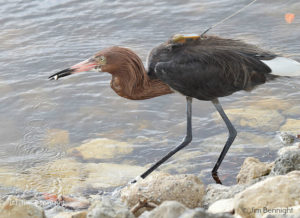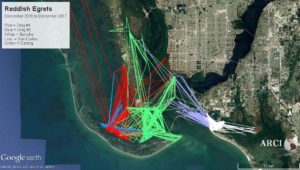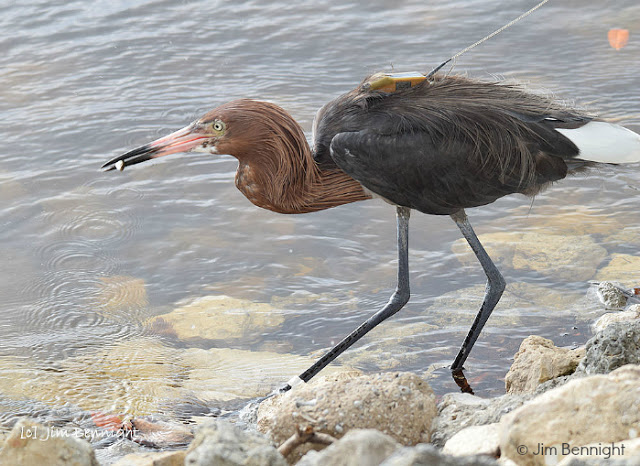“We bid farewell last week to the strikingly handsome male Reddish Egret, Ding#2. He has been an icon of the J.N. “Ding” Darling National Wildlife Refuge’s Wildlife Drive for years, the last five of which while carrying one of ARCI’s tracking devices and contributing over 8,000 precise locations as he fed, rested, roosted, nested, and graced us with his presence on Sanibel. Perhaps you saw or photographed him or his mate, Ding#1, at one of the three big impoundments on the Drive. Ding#2 was one of five adult Reddish Egrets we tagged in Lee County in 2014 and 2015 with financial support from the Ding Darling Wildlife Society (the Friends of the Refuge), Sanibel-Captiva Audubon Society, and a few generous Sanibel residents; and the logistical support of the J. N. “Ding” Darling National Wildlife Refuge.
 |
| Ding #2 enjoys a freshly-caught minnow. He could often be seen foraging at one of the impoundments off the Wildlife Drive at the J.N. Ding Darling National Wildlife Refuge. |
When we learned last week from CROW staff that Ding#2 could not be saved, we wondered how the area’s other Reddish Egrets were faring. Was Ding#2’s fate an unusual occurrence? After all, during last year’s red tide, all our tagged birds seemed unimpaired as they weathered the outbreak. Now that all the egrets’ transmitters have reached the end of their expected life span, we are unable to direct our many friends and supporters to the birds’ last locations to determine whether they are alive, dead, or in need of care. What should we expect for Sanibel’s Reddish Egrets?
The unfortunate answer to these questions began unfolding last Saturday afternoon, November 16th, when we learned from CROW that Darling, the third of the five Reddish Egrets ARCI tagged, had been admitted that day. The circumstances and the birds’ symptoms were painfully familiar. Although this bird was alert at the time, he was not feeding on his own or able to stand. Darling remained in this condition until he died sometime the night of November 20th.
Even if Ding#2 and Darling had survived to be released back into their chosen homes, what would they have faced? We know from colleagues at the Sanibel-Captiva Conservation Foundation who track red tide levels that the 2019 outbreak exceeds the severity of 2018 conditions specifically in the areas where Sanibel’s Reddish Egrets feed the most. Red tide’s impacts vary with the volume of polluted fresh water arriving from Lake Okeechobee via the Caloosahatchie River – an abundant food source for the dinoflagellates that coalesce into the algal blooms we know as red tide. Compounding this factor, warmer Gulf water temperatures resulting from climate change are pushing more red tide blooms on shore and prolonging the duration of each invasion. For Sanibel’s animal residents that are strongly faithful to established, year-round home ranges, such as Reddish Egrets, there simply is no escape.
CROW has been doing an amazing job (please thank them) caring for not just the usual full house of sick and injured wildlife, but also the deluge of red tide victims. We are confident that Ding#2’s final days were as comfortable as possible, as for the time Darling now has while struggling to recover. We are grateful for this, as we acknowledge that there is no sign that the physical, financial, and emotional demands they are facing will soon abate.
What may be next for Reddish Egrets on Sanibel Island? Will the lost birds be replaced? Please consider that Reddish Egrets are already dangerously close to extirpation in Florida after barely showing some short-lived signs of increase following the plume-hunting destruction of 100 years ago, only to reverse course in the 1990s and begin their present downward slide.
 |
| One year of satellite data from five tracked Reddish Egrets. |
Consider also the movement data our imperiled friends produced while still healthy over the last five years, plus what we acquired from tracking a larger number in the Florida Keys. Reddish Egrets in Florida rarely move from their established home ranges, and when they do, it is temporary (not really a seasonal migration). Furthermore, the few places that remain occupied by Reddish Egrets, and which are also close enough to supply re-colonizing birds for Sanibel, are themselves being subjected to red tide. A timely case in point: We just received word that an unmarked Reddish Egret was found today (November 21st) appearing ill and impaired on a Marco Island beach. Unfortunately, it evaded capture, so we may never know its fate.
What should we all do? Vote for leaders, regardless of party and at every level of government, who support a healthy environment and sustainable planet. Pure and simple. This is the most important action we can take to produce sufficient change soon enough and at an adequate scale to begin reversing the certain, deadly course we are now on.
If you need assurances, just look to the birds. They could not possibly be sending us a stronger, clearer, more life-or-death message.”


Leave a Reply